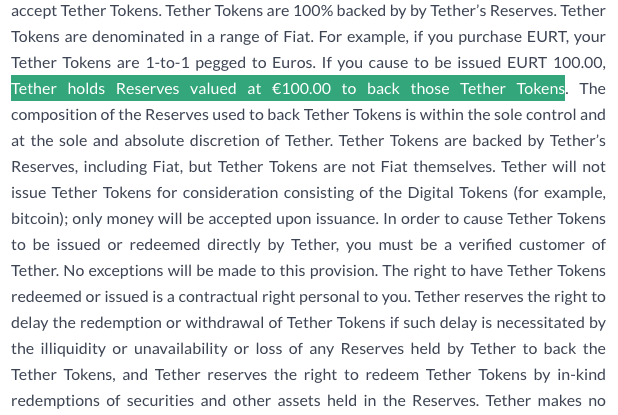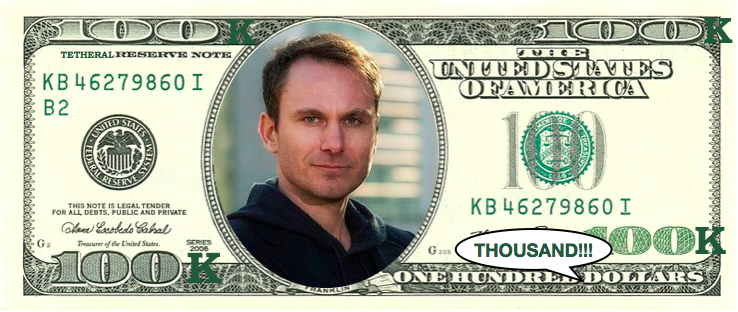Peter McCormack’s podcast with Paolo Ardoino and Stuart Hoegner from Tether/Bitfinex did shed some light on Tether’s operations. Stuart Hoegner, the general counsel, answered most of the questions. Given his position, the devil wasn’t in what he said, but how he said it.
Overall, it was a performance of deflecting questions, making legally true statements, and trying to sound legit AF while accusing “nocoiners” of creating “FUD”. Tether really needed to rebuild some goodwill with the coiner community.
Customers aren’t users
Paolo Ardoino, while explaining how Tether can issue USDTs on weekends, says:
“most of our, uh, biggest customers are banked into the same bank (as Tether, i.e. Deltec)”.
Paolo Ardoino
It’s revealing how he paused after “most of our”, as he was about to say “most of our customers” - which would have been very weird. How come those hundreds of thousands of people who use USDTs all over the world could ALL have an account at a small banking institution in the Cayman Islands?
In fact, it’s not weird at all - Tether is calling “customers” a very small number of actual users, the ones Tether is issuing USDTs. The rest aren’t customers, they’re users. The distinction is very important, for Tether also says that they perform complete AML and KYC on their customers. This means that they know who are the people (some exchanges and OTC desks) to whom they issue USDTs; but after that first step, feel free to do whatever you want, the blockchain is your oyster!
Stuart also points out at the end of the interview that they don’t have US customers. Which also makes his claim that they’re regulated by FinCEN much less grand - after all, it’s not that hard to comply with regulations when none apply.
Reserves are YOLO
Reserves? We definitely have some
At the time Stuart had to swear on the NYAG affidavit, he admitted that Tether’s reserves were 74% cash and equivalents, the rest being an IOU from Bitfinex. He says, “USDTs are 100% backed by reserves, so the loan to Bitfinex is still good backing”, and later on, “so maybe people object to the amount of the backing, but it’s not nothing”. Oh it’s not nothing, case closed!
One thing is clear - these reserves aren’t cash. It can be whatever Tether wants, valued at prices convenient to them:

The rule of thumb is, whenever Tether talks about dollars, they don’t actually talk about dollars, but about their reserves, which aren’t dollars. Stuart says,
“[at the time of the affidavit,] other than $2.1B in reserves (and today, just for context, that amount has grown to $22B), Tether had cash and cash equivalents on hand representing approximately 74% of the current outstanding USDTs). Just note that that loan is now $550m out of almost $22B in reserves - 2.5% of the total.”
Stuart Hoegner
So we know the nature of 2.5% of their overall reserves - it’s the Bitfinex loan - but that doesn’t mean that the rest is cash. Why focus so much on such a small portion of their portfolio, then, if it isn’t to distract?
If you listened to the interview, you must have noticed how carefully Stuart is wording what he says, and the result is certainly very confusing for the average listener, who is entitled to believe they really have the $22 billion. I certainly heard exactly that, until I rewinded and listened to Stuart speak all over again.
Backed by loans, like fiat
Stuart also mentions “third party loans” as part of their reserves, like the loan to Bitfinex. Which is exactly how the fiat banking system works: banks will credit your account with new dollars if you sign an IOU. And it could very well explain how Tether ended up with a Bitfinex loan in the first place: Bitfinex needed 850m USDTs, didn’t have $850m, but simply signed an IOU for $850m. If you’ve seen the document, where Giancarlo Devasini, CFO of Tether and Bitfinex, signs both for Tether and Bitfinex, it’s epic.
Tether’s select few customers can access the USDT printer without any cash, and use the new USDTs for whatever they want. And you still wonder why Bitcoin has gone parabolic lately?
Pumping Bitcoin
Tether owns Bitcoin, and they don’t want to say why
Peter McCormack asks them, point blank, if they own Bitcoin, and if they use Tether to pump Bitcoin.
As per the affidavit, Stuart confirms that they own Bitcoin:
“part of it is in Bitcoin; if nothing else, there are transaction fees, that need to be paid on the OMNI layer… we don’t presently comment on our asset makeup, overall, but we are contemplating starting a process of providing updates on that on the website this year”.
Stuart Hoegner
Note how Stuart doesn’t say that the only Bitcoin they have is for the OMNI layer transactions. So they have other Bitcoin as well? And by the way, why are supposedly segregated customer assets being used to pay for operational costs?
Peter insists, “What’s the process of the Bitcoin reaching your basket?”, and this time Stuart deflects, “Paolo, do you have any comments on that?”
Left alone neck deep in shit by his lawyer, Paolo has no choice but to ask Peter to change the question:
“Well, ummm… so… I’m not sure if the question is really clear. Are we talking about how we acquired the Bitcoin that we need to fulfil the OMNI layer transactions?”
Paolo Ardoino
No Paolo, the question was why do you have Bitcoin in your reserves, not why you have a few Bitcoin for clear operational reasons. Why don’t you want to answer it?
Tether buys Bitcoin, and they don’t want to say it
When McCormack asks Stuart if they buy Bitcoin on the market, “at the right time”, and then pump it with Tethers, Stuart replies,
“we don’t have the ability to buy Bitcoin at the right time in the market, we’re not prognosticators about wether the market’s gonna go up or down, that presumes some level of clairvoyance which we don’t have”.
Stuart Hoegner
Well OK but the question wasn’t if you can see the future, but if you buy Bitcoin - why deflect it in such a weird way?
Peter insists “people say that you have the ability to pump the market by issuing Tethers”, to which Stuart replies, “We don’t issue Tethers to buy Bitcoin. We issue Tethers to customers who want Tethers.” So if a customer that happens to be Bitfinex wants to pump Bitcoin with USDT, that’s fine.
Then Paolo answers with its own rhetorical question.
“The entire concept of us issuing Tethers to buy Bitcoins for ourselves doesn’t make sense. Why issue Tethers when we already have the dollars, and we have the ability to manage our inventory and out portfolio, when we could just use the dollars? The entire narrative is completely nonsense. Why do we have to do two steps when we can do one?”
Paolo Ardoino
To answer Paolo’s rhetorical question with another rhetorical question, may I venture,
“Why buy Bitcoins with real dollars, which are hard to get by, when you can simply print 20,000,000,000 USDTs that cost you nothing? Is it really because you’re too busy and want to save one step?”
Trolly McTrollface
No (unmet) redemptions
Stuart boasts that all USDT redemption requests have always been met. Well, given Tether’s contract, that’s a pretty low bar:

The whole USDT contract is just incredible, when you read it. USDTs aren’t legal claims on Tether’s reserves. Maybe they are for Tether’s customers, who might have signed a different agreement with Tether. But if you’re not a Tether customer, USDTs are just digital toilet paper. You might be left with it forever on the blockchain, as a stark reminder that database entries without a contract in the real world, are utterly worthless.

